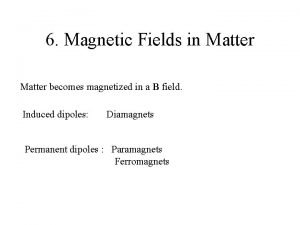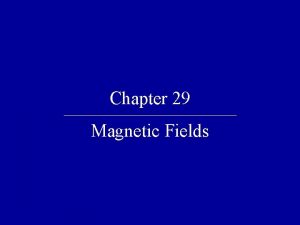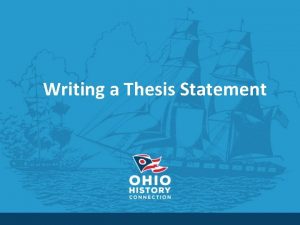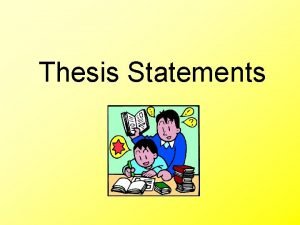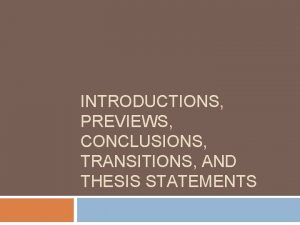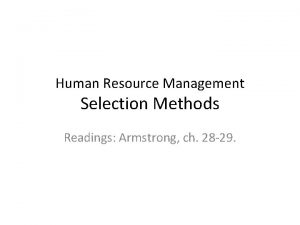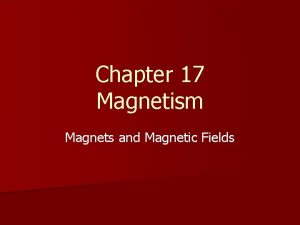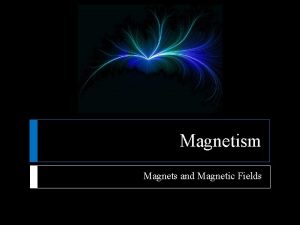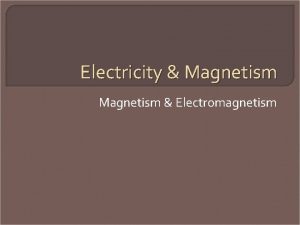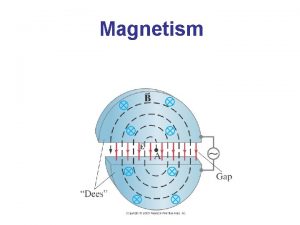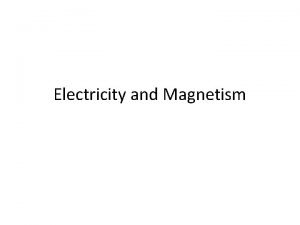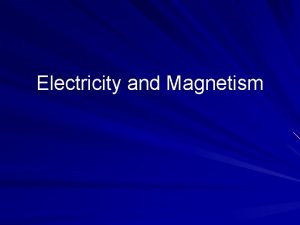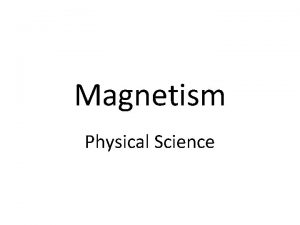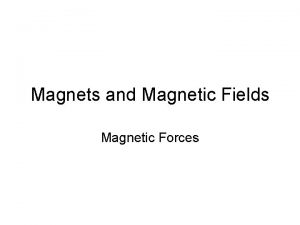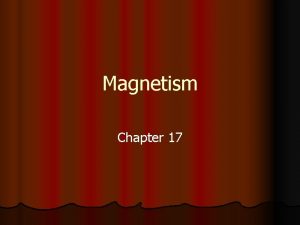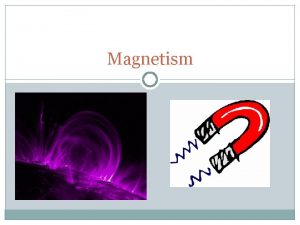Magnetism Section 1 Magnets and Magnetic Fields Preview
















- Slides: 16

Magnetism Section 1: Magnets and Magnetic Fields Preview • Key Ideas • Bellringer • Magnets • Magnetic Fields • Earth’s Magnetic Field

Magnetism Section 1 Key Ideas 〉 What happens when the poles of two magnets are brought close together? 〉 What causes a magnet to attract or repel another magnet? 〉 How is Earth’s magnetic field oriented?

Magnetism Section 1 Bellringer 1. Most of us use magnets in our daily life without thinking about it. Name five places that you use magnets. 2. If you had two bar magnets and you touched the end of one bar magnet to the end of the other bar magnet, what are the two possible outcomes? If you rotated one of the bar magnets 180°, what are the two possible outcomes? 3. Explain why a compass is a useful tool for navigation.

Magnetism Section 1 Bellringer, continued 4. On Earth, there is the magnetic N pole and the geographic North Pole. According to the picture above, are they located at the same geographic location? Where do you think the magnetic S pole is located?

Magnetism Section 1 Magnets 〉 What happens when the poles of two magnets are brought close together? 〉 Two like poles repel each other. Two unlike poles attract each other. • magnetic pole: one of two points, such as the ends of a magnet, that have opposing magnetic qualities – All magnets have at least one pair of poles, a north pole and a south pole. – It is impossible to isolate a magnet’s south pole from the magnet’s north pole.

Magnetism Section 1 Visual Concept: Magnetic Poles Click the button below to watch the Visual Concept.

Magnetism Section 1 Magnets, continued • Some materials can be made into permanent magnets. • A magnetized piece of iron is called a “permanent” magnet, but its magnetism can be weakened or even removed. • Iron is a soft magnetic material. • It is easily magnetized. • It tends to lose its magnetic properties easily. • Cobalt is a hard magnetic material. • It more difficult to magnetize. • Once magnetized, it doesn’t lose its magnetism easily.

Magnetism Section 1 Visual Concept: Magnetic Materials Click the button below to watch the Visual Concept.

Magnetism Section 1 Magnetic Fields 〉 What causes a magnet to attract or repel another magnet? 〉 Magnets repel or attract each other because of the interaction of their magnetic fields. • magnetic field: a region where a magnetic force can be detected

Magnetism Section 1 Magnetic Fields, continued • Magnets are sources of magnetic fields. • Moving charges create magnetic fields. • magnetic domains: groups of atoms that all line up the same way and form small, magnetized regions within a material • Magnetic field lines are used to represent a magnetic field. – Field lines always form closed loops. • The magnetic field gets weaker with distance from the magnet.

Magnetism Section 1 Magnetic Fields, continued • Magnetic field lines that are close together indicate a strong magnetic field. • Field lines that are farther apart indicate a weaker field. • Magnetic field lines begin at the north pole of a magnet and end at the south pole of the magnet.

Magnetism Section 1 Visual Concept: Magnetic Field Click the button below to watch the Visual Concept.

Magnetism Section 1 Magnetic Fields, continued • Compasses align with Earth’s magnetic field. – The compass points in the direction that lies along the magnetic field line at a given point. – By convention, the pole of a magnet that points north is painted red.

Magnetism Section 1 Earth’s Magnetic Field 〉 How is Earth’s magnetic field oriented? 〉 Earth’s magnetic field lines run from geographic south to geographic north. • The pole in Antarctica is a magnetic north pole. • The pole in northern Canada is a magnetic south pole.

Magnetism Section 1 Earth’s Magnetic Field, continued • Earth’s magnetic field has both direction and strength. • The source of Earth’s magnetism is not yet fully understood. – The iron in the core is too hot to retain any magnetic properties. – The circulation of ions or electrons in the liquid layer of Earth’s core may be the source of the magnetism. • The sun also has a magnetic field and ejects charged particles into space.

Magnetism Section 1 Visual Concept: Earth’s Magnetic Field Click the button below to watch the Visual Concept.
 Lesson outline lesson 1 magnets and magnetic fields
Lesson outline lesson 1 magnets and magnetic fields Magnetic field lines of a bar magnet
Magnetic field lines of a bar magnet Red fields to green fields
Red fields to green fields Conceptual physics magnetism
Conceptual physics magnetism Learning: module 26: magnetic forces and fields
Learning: module 26: magnetic forces and fields Electric currents and magnetic fields
Electric currents and magnetic fields Electric currents and magnetic fields
Electric currents and magnetic fields Magnetic field in matter
Magnetic field in matter Magnetic fields quick
Magnetic fields quick Hysteresis loop magnetism
Hysteresis loop magnetism Magnetic flux density and magnetic field
Magnetic flux density and magnetic field Magnetic moment and magnetic field relation
Magnetic moment and magnetic field relation Magnetic force particle
Magnetic force particle Thesis statement examples
Thesis statement examples Thesis statement in summary
Thesis statement in summary Thesis and preview statement example
Thesis and preview statement example Realistic job preview advantages and disadvantages
Realistic job preview advantages and disadvantages







